Tahiti and the islands in art: introducing Jacques Boullaire
Beautiful sketches of beautiful places and beautiful people.
There is a massive energy that flows through the islands. The locals call it mana and it’s a sacred force, something that connects and inhabits all living things.
I think this mana comes out in the creative energies of the people here. There are so many ways that creativity is celebrated in everyday objects; beautifully crafted hats, bedspreads, flower crowns, sculpture and art.
Women pick flowers from the side of the road to tuck behind their ear, men wear shirts in bold and colourful patterns. It’s not just the landscape that’s a feast for the eyes!
There are some incredible artists who have tried to capture the spirit of the islands, and artists of all kinds continue to flock here. I’m told this is one place where you actually stand a chance of making a living as an artist, as artists and craftspeople of all kinds are so prized.
I was originally going to make a list of some of my favourite artists I’ve come across, then I just kept writing and writing… and writing…
So, change of plans. I’m going to focus on one artist at a time, and this week it’s the magnificent work of an artist I’d never heard about before arriving here.
Jacques Boullaire
“Boullaire and Oceania: How did this romance begin? We may never know.”
Aiu Boullaire-Deschamps & Emmanuel Deschamps, from Tahiti: a Sketchbook & Tahiti: Carnet de croquis, Sketchbook II.
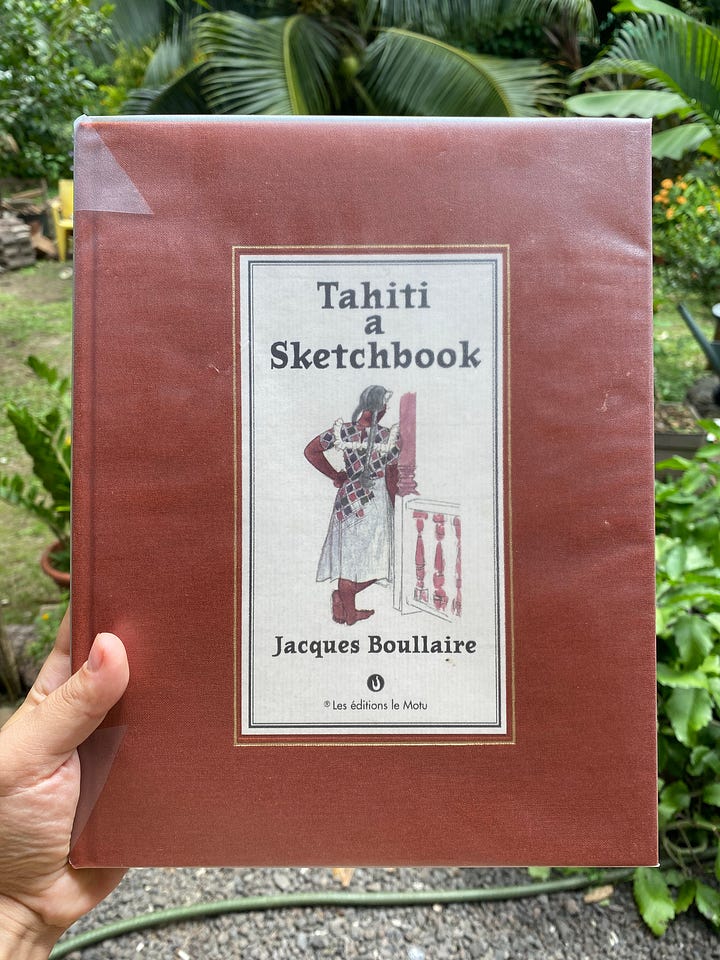
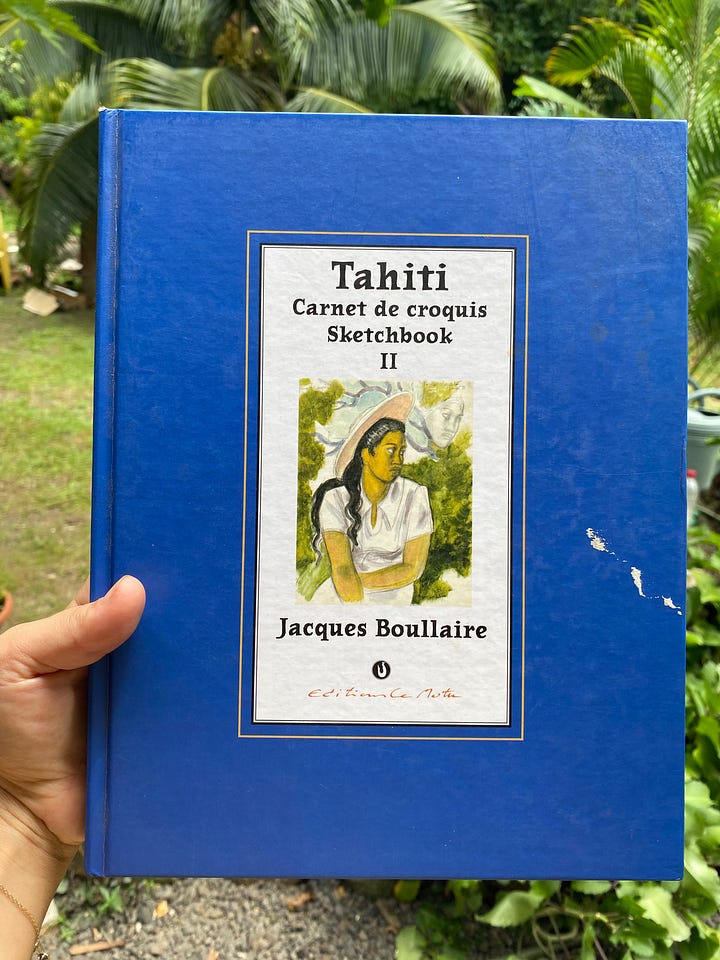
Born in 1893 to French parents, apparently Jacques Boullaire had terrible eyesight despite becoming a fighter pilot in WWI. It doesn’t seem to have stopped him from creating a truly impressive volume of work.
While in France he meets Anne Hervé, the daughter of the administrator of the Tuamotus, born in the Pacific to parents who left Brittany for a life of adventure in the islands. Apparently she liked to run around Paris with no shoes. She inspires him with stories from her childhood of island life with no running water or electricity.
Together, they fall into a passionate and artistic relationship, and leave for Tahiti.
“He is charmed, although not yet conquered, by the excessiveness of Oceania. The trees are a shade of green that does not seem to exist in a set of water colours; the fish look like flowers, and the flowers are stunning in their immensity and colouration.”
Aiu Boullaire-Deschamps & Emmanuel Deschamps, from Tahiti: a Sketchbook & Tahiti: Carnet de croquis, Sketchbook II.
Jacques and Anne would spend a year in Tahiti before returning to France and living like shepherds in the countryside with their young daughter, Aiu, to escape WWII. They then trundle around the French countryside for a while in a custom-built van (the original van-lifers?) while Jacques works on both personal and commercial projects.
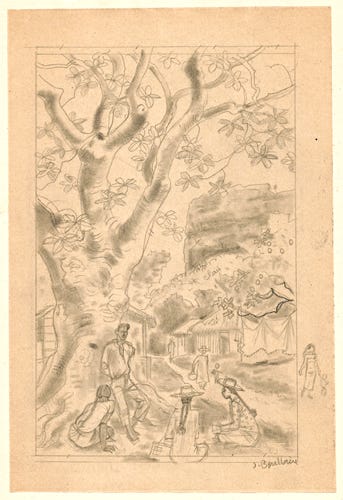

Their return to Polynesia was supposed to last one year, and instead lasted 4; sometimes they were camping and living on the beach in a tent, cooking fish on the fire. Sometimes they were being hosted by friends or even at the Queen’s house.

“Endlessly observing, he draws only a little. Eyes half-closed against the violence of the sun on the sparkling lagoon, little by little he acclimates his body and eye to the tropics. Yet his pencil hesitates before the absurd, curved trunks of the coconut palm.”
Aiu Boullaire-Deschamps & Emmanuel Deschamps, from Tahiti: a Sketchbook & Tahiti: Carnet de croquis, Sketchbook II.
The book Tahiti: a Sketchbook and Tahiti: Carnet de croquis, Sketchbook II describes Boullaire’s relationship with the local people and the landscape as joyful. He bribes children with sweets to sit still in their natural poses, his wife Anne tries to distract the women with broken conversation who often break into laughter as Jacques quickly sketches what he sees.
I love the pure joy that emanates from his sketches of Tahitian life. Little snapshots of people lounging , working, going about their day. The loose, playful landscapes.
When they return to France, Jacques has over 4,000 sketches of the people, places and nature of the islands. He would return only once more in his life, as a frail, old man.
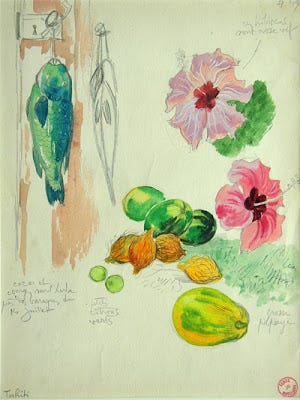

I’m always inspired to pick up a pencil when I look at Boullaire’s work. The sheer volume speaks to a hunger to capture everything while he can, of seeing beauty in the small details of every day life.
He had 4,000 sketches within 4 years. My new aim is to have 4,000 sketches at the end of my entire lifetime.
Reading, watching, thinking about…
It’s nearly Christmas! I’m loving the idea of doing some easy upcycled crafting with the niece and nephew, like these cardboard stars or these homemade wreaths.
How happy music from the 2000s and 2010s makes me
I feel like you know you’re officially old when you just want to listen to the bands you were seeing live in your teens and 20s. I’m choosing to embrace it!
My toxic trait is that I have purchased exactly zero Christmas presents for other people and I’m already thinking I should treat myself.








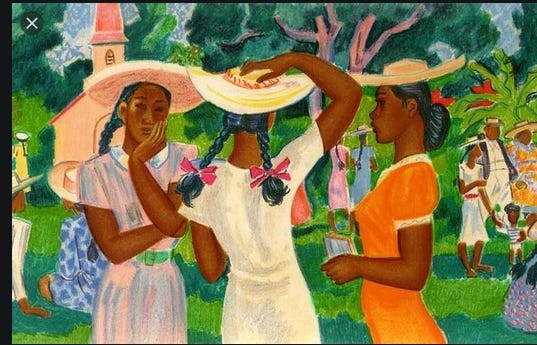


I love the touch of nostalgia in his paintings. I mean, in the sense that what he depicted now has the flavour of an era that is fading away...